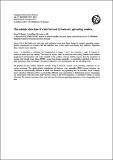Por favor, use este identificador para citar o enlazar a este item:
http://hdl.handle.net/10261/140945COMPARTIR / EXPORTAR:
 SHARE
BASE SHARE
BASE
|
|
| Visualizar otros formatos: MARC | Dublin Core | RDF | ORE | MODS | METS | DIDL | DATACITE | |

| Campo DC | Valor | Lengua/Idioma |
|---|---|---|
| dc.contributor.author | Ranero, César R. | - |
| dc.contributor.author | Grevemeyer, Ingo | - |
| dc.date.accessioned | 2016-11-29T13:38:50Z | - |
| dc.date.available | 2016-11-29T13:38:50Z | - |
| dc.date.issued | 2015-04-15 | - |
| dc.identifier | issn: 1607-7962 | - |
| dc.identifier.citation | Geophysical Research Abstracts 17: EGU2015-7673 (2015) | - |
| dc.identifier.uri | http://hdl.handle.net/10261/140945 | - |
| dc.description | European Geosciences Union General Assembly 2015 (EGU2015), 12-17 April 2015, Vienna, Austria.-- 1 page | - |
| dc.description.abstract | About 3/4 of the Earth crust and most past subducted crust have been formed at oceanic spreading centers. Seismic experiments on oceanic crust that underlies most of the world ocean basins have defined a ubiquitous three-velocity-layers structure. Layer 1 is identified as sediment, but interpretation of layers 2 and 3 has remained a topic of intense research for more than half century. The nature of oceanic crust at basins has been mainly inferred from indirect geophysical measurements and rocks sampled at the seafloor. Current models propose that the formation of oceanic crust at mid ocean ridges (MOR) –away from hotspot anomalies- is essentially controlled by the rate of plate separation, with crustal types classified as ultraslow, slow, intermediate, and fast spreading crust. We present the first modern extensive seismic study of back-arc oceanic crust providing constrains on accretion processes. The depth-velocity distribution of back-arc crust resembles MOR layered structure, but velocities are systematically different to MOR crust formed at any spreading rate. In particular, Layer 3 display lower velocities, indicating either a considerable different rock composition or deformation process. Integrating our observations with data from other back-arc basins of the world indicates a considerable variety of crustal velocities. The seismic structure of the crust indicates that back-arc spreading represents a class of spreading in its own | - |
| dc.publisher | European Geosciences Union | - |
| dc.relation.isversionof | Publisher's version | - |
| dc.rights | openAccess | - |
| dc.title | The seismic structure of crust formed in back-arc spreading centers | - |
| dc.type | comunicación de congreso | - |
| dc.relation.publisherversion | http://meetingorganizer.copernicus.org/EGU2015/posters/17652 | - |
| dc.date.updated | 2016-11-29T13:38:50Z | - |
| dc.description.version | Peer Reviewed | - |
| dc.language.rfc3066 | eng | - |
| dc.rights.license | https://creativecommons.org/licenses/by/3.0/legalcode | - |
| dc.relation.csic | Sí | - |
| dc.type.coar | http://purl.org/coar/resource_type/c_5794 | es_ES |
| item.openairetype | comunicación de congreso | - |
| item.grantfulltext | open | - |
| item.cerifentitytype | Publications | - |
| item.openairecristype | http://purl.org/coar/resource_type/c_18cf | - |
| item.fulltext | With Fulltext | - |
| Aparece en las colecciones: | (ICM) Comunicaciones congresos | |
Ficheros en este ítem:
| Fichero | Descripción | Tamaño | Formato | |
|---|---|---|---|---|
| Urgeles_et_al_2015_EGU2015-7673.pdf | 15,8 kB | Adobe PDF |  Visualizar/Abrir |
CORE Recommender
Page view(s)
113
checked on 22-abr-2024
Download(s)
63
checked on 22-abr-2024
Google ScholarTM
Check
Este item está licenciado bajo una Licencia Creative Commons

